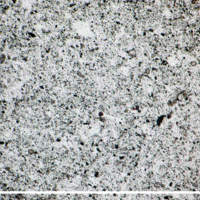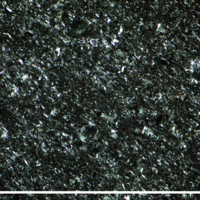- Home
- Rocks
- Type fossils
- Fossil Specimens
- Minerals
- Glossary
- Stratigraphic Chart
- Michel-Levy Chart
- Classification of igneous rocks
- University of Cambridge
- Department of Earth Sciences
- ESC Library
- Moodle
- Sedgwick Museum
- DoITPoMS
- Mindat.org
- Microfossils
- Bryozoans
- Webmineral
- Tree of Life
- CrystalMaker
- Virtual Microscope
L500 - Slate
Age
Lower Cambrian
Location
Llanberis, North Wales
Hand Specimen
Very fine-grained rock with a prominent, well-developed cleavage. The dark red-purple colour is due to iron-staining. The light green smudge is a reduction spot.
Thin-section
Mud size grains.
Mainly indistinguishable clay minerals.
Some quartz, muscovite, opaques.
Rock History
The protolith of this rock was a pelite (mudstone). Under low-grade, regional metamorphic conditions, crystals within the pelite were aligned, producing the slaty cleavage.
Advanced Notes
Iron staining
Hematite(Fe2O3) → red (blood-red, cherry-red, brown-red) iron-staining
Limonite (FeO(OH)·nH2O) → yellow or brown iron-staining
The red-purple colour of this rock is probably produced by hematite.
Reduction spot
The dark red-purple of the majority of this rock is due to the presence of iron in the 3+ oxidation state (Fe3+). The light green colour of the reduction spot is instead due to the presence of iron in the 2+ oxidation state (Fe2+). Hence, reduction of the iron ions from Fe3+ to Fe2+ has taken place in the reduction spot.
Rock Name
slate



